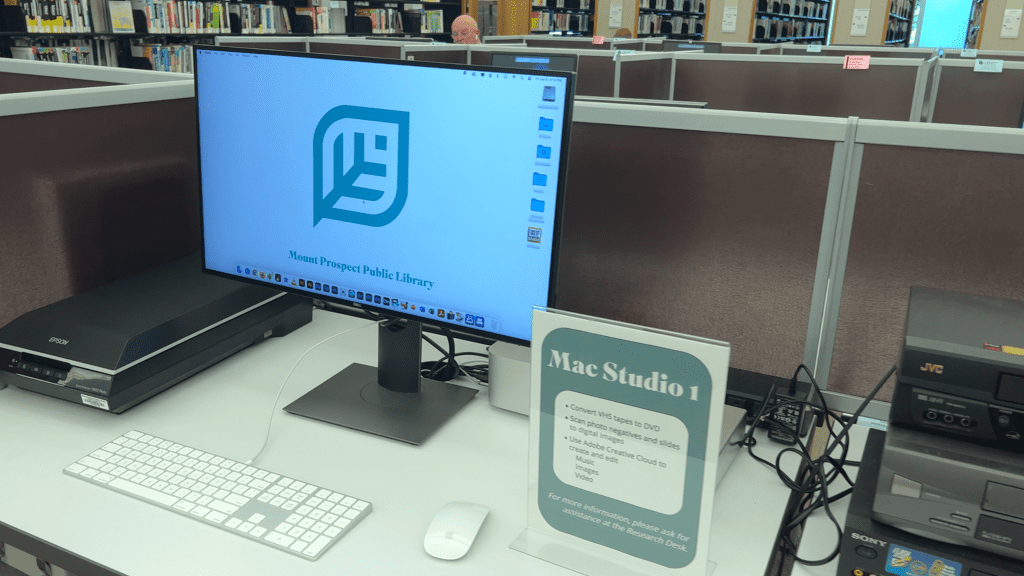Mount Prospect Public Library’s story is one of growth and change. It started small, but has grown to a major suburban library, continually evolving and providing excellent library services to Mount Prospect residents.
Click on a date to learn about the Library’s history. You can also watch a short documentary in which Library Life host Cathy Cushing takes you on a journey through the years of our history from inception to present.
1929-1943
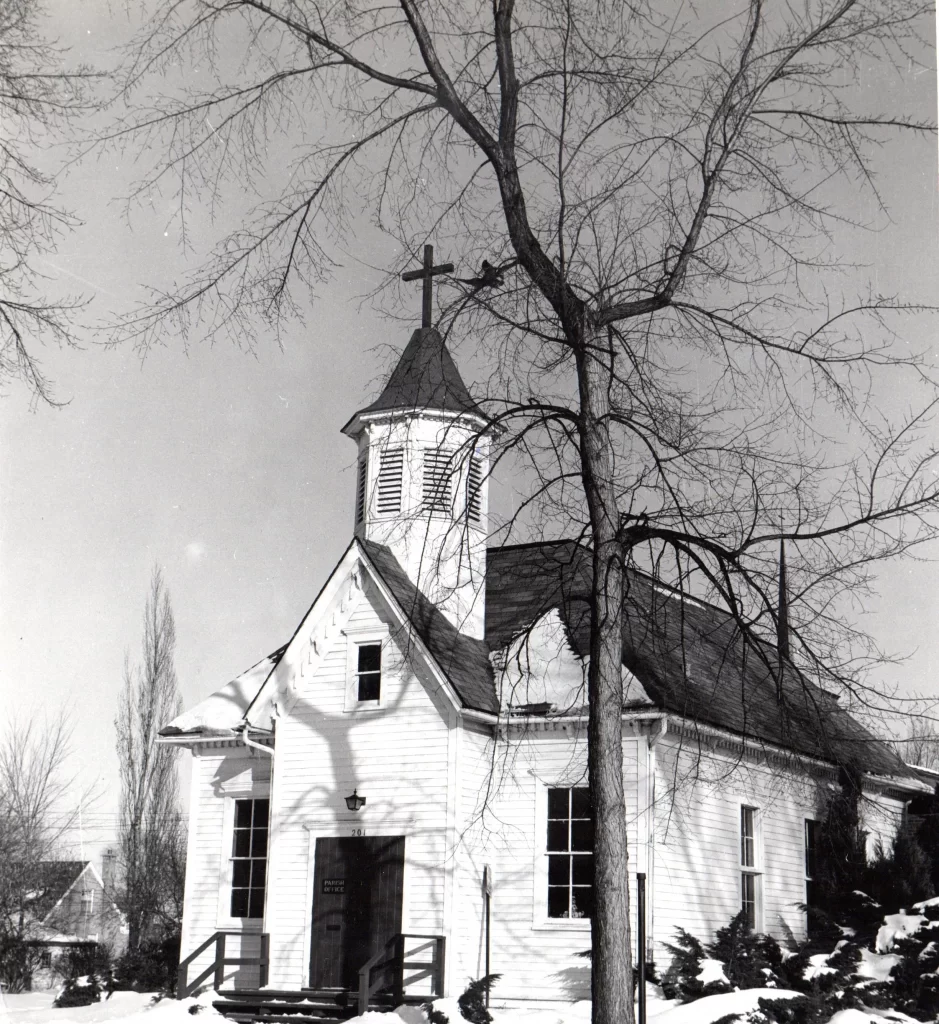

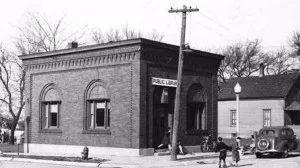
The idea for a public library in Mount Prospect was initiated by the Mount Prospect Woman’s Club in October 1929. The club’s Library committee began going door to door seeking donations of books and money. As reported in a Herald article dated November 1929, the Mount Prospect Improvement Association donated $50 towards the effort, one of many donations of books and money that would be required to keep the Library open for the next 13 years. The Library officially opened on January 6, 1930 in a one-room schoolhouse on the corner of Main Street and Central Road, and was staffed by volunteers from the Woman’s Club. It consisted of a single tier of shelves holding about 300 books. Residents could use the collection one day a week for a few hours.
The Mount Prospect Woman’s Club members strove to offer more by asking for additional donations, offering new books for rent, and seeking guidance from the Chicago Public Library on growing the library. In 1932 they employed Mrs. Irma Schlemmer. By 1934 there were 415 borrowers, and the collection totaled 1,203 books. In 1935, the Woman’s Club asked the Village to provide a new location, since the schoolhouse was no longer available to them. The Village offered a small red-brick building that had formerly housed the Mount Prospect State Bank on the northeast corner of Main Street and Busse Avenue. The Library opened on Thursday afternoons at its new location in September 1935.
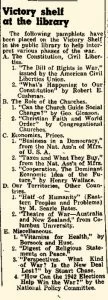
Although the Depression continued through the next five years, Mount Prospect residents were generous, and kept on providing monetary and book donations. The Woman’s Club members canvased for funds each year, using the money to purchase new books. Other ways of raising money were also sought by the Woman’s Club; for example, the proceeds from an amateur talent show hosted by the Lions Club in December 1937 were given to the Library. The collection continued to grow—345 books were added between 1939 and 1940 for a total of almost 4,000 books. From a list of 25 bestsellers in that year, Mount Prospect Library had 17 of the titles on its shelf. Almost 900 cards were issued–at this time there were 1,710 people in the Village. The Library was open only four hours a week, but there was a desire to be open more often, even as the country faced war. A children’s summer reading club was begun in 1942 with 200 children enrolled, and a victory shelf was established in October 1942 to present materials on the war effort.
It became obvious the Library lacked the necessary resources to support current needs of the community. The Library building had no heat or plumbing, and required extensive repairs. By 1942, the idea of establishing a tax-supported library was enthusiastically supported by the public, and by local organizations, such as the Men’s Club and the Parent-Teacher Association. In a letter to Mount Prospect organization presidents, E.H. Cleven of the Men’s Club noted Mount Prospect was the only village between Chicago and Harvard that did not have a tax-supported library. After much promotion by local organizations, the question of tax support was placed on the ballot during the April 1943 election.
The result of the election was 489 in favor to 212 votes against, and Mount Prospect Public Library became tax-supported! The first residents to serve as trustees were Dorothy Kester, Martin Green, Meta Bittner, Ruth Carlson, Edmund Cleven, and Mildred Gallagher. Irma Schlemmer was appointed the first Head Librarian; she would serve in this capacity until December 1966.
The young Library also received much assistance from the Chicago Public Library in the form of professional guidance, furniture, and books. Chicago Public gave the Library 1,000 books for $200 per year, which it then returned to the Library to enable the purchase of children’s books. This help continued for twenty years.
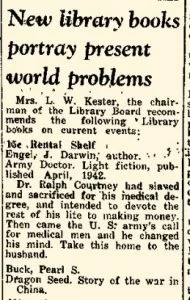
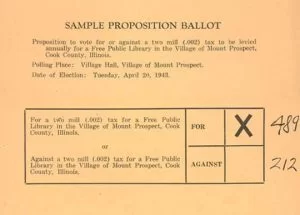
1944-1968
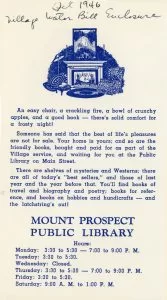
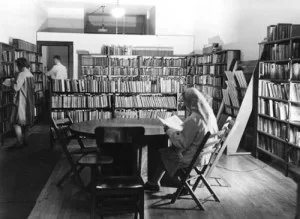
The trustees of the first tax-supported Library board met at each other’s houses because the Library building had no meeting space. They worked diligently to find a new location, settling on a paint store building at 115 S. Main Street. The Library moved and opened to the public in September 1944. The Library was open more hours, offered more books and additional collections, including phonographs, by 1946.
As time went on, it became clear the Library needed its own building. In 1949, Library circulation was 26,400, and by 1950 Mount Prospect had 4,009 residents. The Library Board was able to secure a lot at the northwest corner of Busse Avenue and Emerson Street with funds donated by community members. A $35,000 bond referendum was approved, and the first dedicated Mount Prospect library building was built. The Library moved into the building in July 1950.
In 1955, members of the Woman’s Club celebrated the 25th anniversary of the founding of the original volunteer Library in 1930. Meanwhile, Mount Prospect kept growing. In 1962 there were around 20,000 residents and 30,000 volumes in the Library collection. In response, the Library added an addition on the west side of the building, which was financed by a bond in 1961. The square footage of the building was 11,886; this provided room for a children’s area and a more spacious lobby. An open house revealed the changes to the public in November 1962.
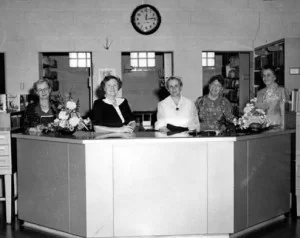
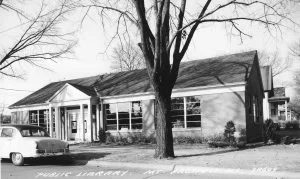
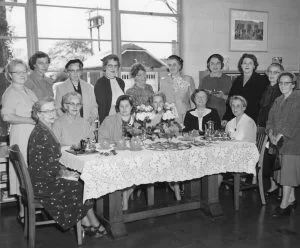
Mary Jo Hutchings became the Head Librarian in 1966, and faced many challenges, including societal changes, difficult finances, contentious relations with the Village Board, growing demand for services, and a lack of space. The Library remained a lively and busy place; the Friends of the Library group helped with special programs and celebrations such as National Library Week. Paul Powell, Illinois Secretary of State, also visited Mount Prospect in 1966.
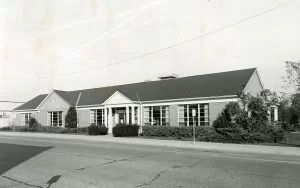
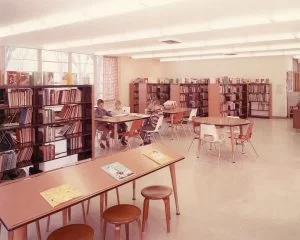
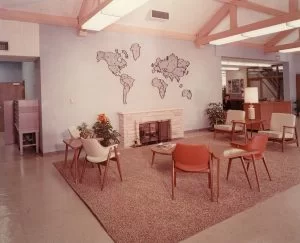
New services continued to come to the Library. Magazine microfilm and a microfilm reader were added through a donation from a special memorial fund. The collection of 33 rpm records was expanded. 8 mm films became part of the collection in 1968, and a copy machine in September 1968. It was at this time the North Suburban Library System, composed of 27 area libraries, was formed to facilitate collaboration among the libraries. Despite troubled finances and a threatened service cut, there were many things to celebrate at the Library’s 25th anniversary as a tax-supported library on October 6, 1968.
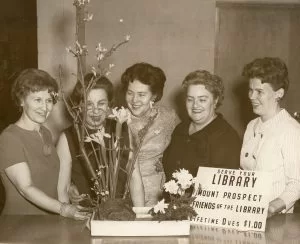
Mount Prospect patrons used the Library frequently to check out books and records. They also attended storytimes, National Library Week events, and participated in the summer reading program. It was a tight fit, however; the expansion done in 1962 was no longer sufficient space. Smaller renovation projects helped for a short time. The number of staff increased, cataloging procedures were standardized, and professional education was emphasized.
1969-1984
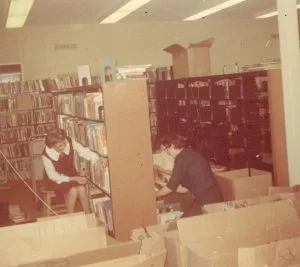

By 1969 Mount Prospect had nearly 35,000 residents. To expand, the Library literally required the roof to be raised. This allowed the children’s room to move to the second floor. Staff, Library board members, and volunteers from other clubs moved the books. A young adult area with fiction and nonfiction materials was arranged around the fireplace, and the Library’s main entrance was now on Emerson Street. The Library welcomed patrons at an open house event on January 25, 1970.
The 1970s brought more challenges for Mount Prospect and the Library. More areas were being annexed into the Village, and the Library provided more services, such as resources for the visually impaired, films, and art prints. It was difficult to fit all the department offices and work space in the building, so the Library added a mobile unit in 1972. It sat in the Emerson parking lot next to the Library, housing technical services staff working on tasks, such as cataloging and processing books. Students, meanwhile, used Library resources in a very cramped atmosphere.
Under the leadership of Library Board President John Parsons and Village President Robert Teichert, the Library purchased the old Central School property. The use of $4 million in Village bonds without a referendum was controversial. Construction started for a new building at the corner of Central and Emerson Streets in 1975. It opened on December 6, 1976, and an open house was held on December 12. The Library was formally dedicated on January 23, 1977, serving a community of 51,974 residents.
The new 45,500 square foot building included a computerized circulation system, sheltered parking, a loading dock, a 125-seat meeting room, a 26,000 square foot adult services area, and a 7,000 square foot Children’s Department. Future expansion possibilities were provided in the building’s structure.
The new Library faced funding challenges. A referendum in October 1977 to raise the tax levy for book purchases failed. Money raised by special community events helped the Library to acquire more books. A drive-up window was provided in 1978. Another referendum to increase operating tax revenue in November 1979 passed.
As the 1980s began, with 20 full-time and 13 part-time employees, the Library continued to respond to the needs of patrons. Patrons could now take advantage of audio cassettes, films, genealogy microfilm, and a government information center. A collection of videotapes was started, and programs for all ages, including bus trips, were offered. In May, 1981, Patricia Kelly became Head Librarian, a volunteer program began, and evening hours of service were extended. The Teddy Bear Walk began a holiday tradition in 1982. An updated automated circulation system was up and running in 1983.
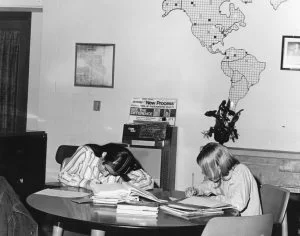
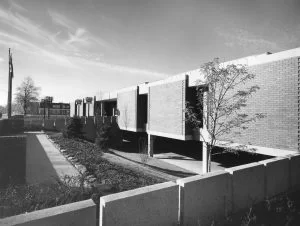
1985-1999
During the mid to late 1980s, programming at the Mount Prospect Public Library continued to thrive. All kinds of topics were covered, including storytelling, a photography contest, crafts, genealogy, adult literacy, financial information, and microcomputers. The Library board’s 1985 long-range plan included adding compact discs to the collection and exploring alternative ways of providing Library services, such as a bookmobile. Books remained vital to the Library; the book budget was increased significantly during these years. The maintenance of the building was an ever-present issue; replacement of the roof was discussed in 1985. An outdoor sign was installed at the corner of Central Road and Route 83 in July, 1985. It became an electronic sign in 1989, funded by the Friends of the Library. The Library was very involved in the creation of an arts council that was formed in February 1986.
As the collection grew (the video collection now had 500 titles), it became apparent that a building of 50,000 square feet would not house it and a growing staff properly. Between 1966 and 1986, circulation increased from 383,056 to 580,000. Plans for building expansion were explored in February 1986; an architect was selected in April 1986. Funds for employing more staff were also sought. By the end of 1986, as board and staff celebrated 10 years in the Emerson building, the Library had 174,000 books, 68 staff members, and was open 79 hours per week. However, a referendum tax hike for the Library expansion held in April 1987 did not pass; neither did a second try in November 1987.
As a result of the loss of the referendum, service hours were cut from 79 to 69 hours a week. Charges for certain services and materials were adopted, while reciprocal borrowing restrictions were implemented. Less space was available for leisure seating. Despite these difficulties, the Library staff continued to offer children’s and adult programs, including computer software programs and all other services. A new roof was finally put on in July, 1988.
Even as the Library dealt with financial issues, staff continued improving the Library’s computer technology. By 1989, patrons with computers at home were able to view the Library’s title records by using a telephone modem connection. The Library also operated a computer bulletin board.
The Library’s collection continued to become more diverse. The Library sought to acquire paintings by Mount Prospect artists to add to its collection. Books remained the largest part of the collection—in August 1989 the Library celebrated the acquisition of its 200,000th book. In 1990, the Library became a federal government depository. The Harold Weary Genealogy Collection was named for a long-time Library volunteer who was active in the local genealogy society.
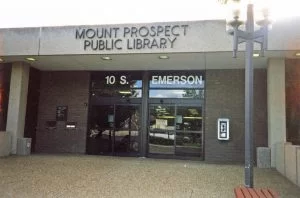
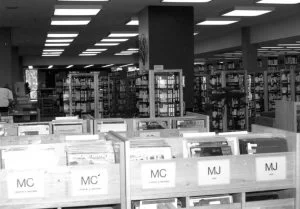
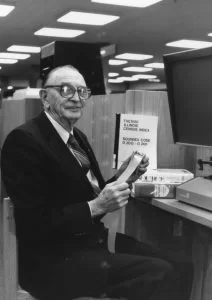
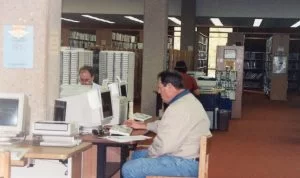
The Library Board, under leadership of Jewell Kern, Trustee, established the Founders’ Award in 1990 – the highest honor the Board could bestow. It reflected the hard work and vision of the men and women who established the Village’s first library. Robert D. Teichert, former Mayor, and John W. Parsons, former President of the Library Board, were the first honorees. The staff remained a key part of the Library’s service to Mount Prospect. Executive leadership was Patricia Kelly, the executive director, and Marilyn Genther, deputy director.
As the 1990s proceeded, the Library continued to manage operations in a less than ideal work space. The Administrative staff was moved into offices in the second floor “penthouse,” former offices of the Municipal Conference. The meeting room was made available to Mount Prospect non-profit groups for a fee. In September 1991 the Library’s first online catalog, CLCAT, debuted; this allowed for more efficient searching. The Library offered Harper video courses for students, and resources for local businesses and job seekers were also provided. These services were in addition to a collection of 245,191 print and 32,912 non-print items. 70% of Mount Prospect residents had library cards in early 1992.
In preparation for the Village’s 75th anniversary in 1992, the Library partnered with the historical society and Village to create a collection of oral histories.
In May 1992, Patricia Kelly retired. Marilyn Genther became executive director in July 1992. She took the position as the Library and the community faced issues such as the implementation of the Americans with Disabilities Act, cuts in services from the North Suburban Library System, downtown redevelopment, homelessness in the Northwest suburbs, limited space, and ongoing financial challenges. Demand for Library services remained high. The Library celebrated its 50th Anniversary in 1993. About 1,000 people came to the birthday party on September 10, 1993, and enjoyed one of the biggest cakes, made by Continental Bakery, that the Village had seen.
A referendum for expansion of the Library in 1994 was unsuccessful. By 1995, patrons had access to the Internet, and the Library had its first webpage. The collection reached 300,000 volumes, and another attempt to get a referendum passed failed. Access to the World Wide Web was made available to the public through the graphical browser Netscape in 1996.
By the end of the twentieth century, public computer use increased dramatically, and a third of circulation was of AV materials. The Mount Prospect Public Library Foundation was formed in 1997, and MPPL prepared for Y2K.
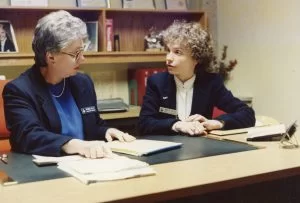
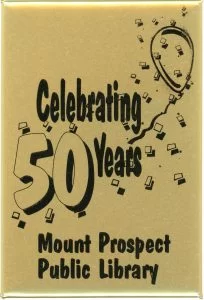
2000-Present
Along with the rest of the world, MPPL entered the 21st Century with celebration and caution. There were many questions about where this century would lead. Library staff focused on continuing excellent public service, serving a community of 56,265 residents.

The Collection Management Department was formed in 1999 to streamline the selection and acquisition of materials. A special focus on Readers’ Advisory responded to a growing desire for fiction reading guidance and book discussion groups. Educational and entertainment programming expanded for adults and children.
Lack of space continued to be pressing. In 2001 the collection numbered 369,475 print and audiovisual items, and shared 49,000 square feet with 16 public Internet access computers. The AV materials now included DVDs. Plans were revisited to add a full second floor. In the meantime, in order to allow for better traffic flow, the Circulation lobby area was remodeled, including installation of new Adult and Youth Services desks. This work was paid for by a State grant. The Library’s local cable TV program Library Life was born in 2001.
The Library board posed the question to expand to the community on March 19, 2002. The $20.5 million bond referendum passed by a 60% majority. The Library finalized plans for the expansion and renovation, and staff began the complicated process of moving to a temporary facility at 852 Feehanville Drive in the Kensington Business Center. A closing ceremony at the old building was held on November 1, and the move to the Feehanville site began on November 4. All Library programs and services were again available in December 2002. A Beam Raising ceremony was held on April 11, 2003 to mark the start of construction on the new Emerson building.
The Library finalized plans for the expansion and began the complicated process of moving to temporary facilities at 852 Feehanville Drive in the Kensington Business Center. A closing ceremony at the old building was held on November 1, and the move to the Feehanville site began on November 4. All Library programs and services were again available in December 2002. A Beam Raising ceremony was held on April 11, 2003 to mark the start of construction on the new Emerson building.

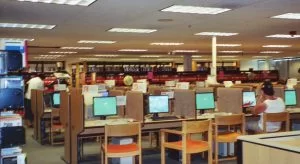
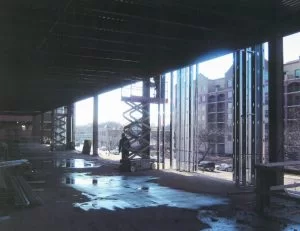
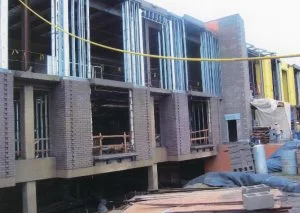
While the Library was at the Feehanville building, it celebrated its 60th anniversary in September 2003. A migration to a new online catalog system, Dynix occurred (ILS). Annual circulation that year was 612,649 items. 433,906 items were in the collection.
Back at the Emerson site, construction of the new building continued through 2003. By December 2003, its new exterior appearance with larger windows was apparent.
The Library moved to the new Emerson building in August 2004. This structure had 101,290 square feet of space, and included two levels with underground parking and a mechanical penthouse. Other features included three public meeting rooms, a computer training room, 51 public computer stations, a Teen Zone, and 6 study rooms. The Library officially opened to the public in September 2004. An open house for area libraries was held on September 10, and a Grand Celebration was held on October 17, 2004.
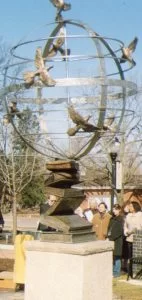
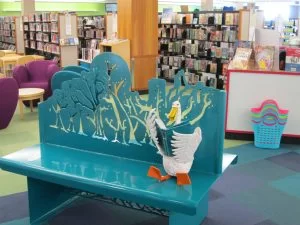
Once the renovated Library opened in 2004, it became a busy community center. Items from the cornerstone of the 1950 building were placed in a new home next to the location of the 2004 time capsule in 2005. The years 2005 to 2017 brought more visual interest and color to the building with the purchase of permanent public art; this included the outdoor Peace sculpture by Erik Blome, which was dedicated to Elizabeth J. Clough. In 2006, the duck bench with Monty, sponsored by of the Friends of the Library, was added to the Youth Services department. In 2007, a major re-design of mppl.org was launched.
The Library continued its services, including research and readers’ advisory help, storytimes, summer and winter reading programs, and educational presentations. Outreach services and program offerings increased exponentially.
There was even a visit from an astronaut in 2009–Dan Tani, brother of Richard Tani, Board member. New services were also added, including in-library wireless access and downloadable e-books. Computer classes helped patrons navigate the changing electronic world, and librarians provided the convenience of setting appointments for special one-on-one reference help. In 2009, the South Branch on Algonquin Road was opened in the Community Connections Center; it has become a vital place in the south side community, helping many residents who are unable to come to the Main branch. 2009 also marked the first time annual circulation hit one million.
Book Crossing (Lectures Croisées), the first ever transcontinental book discussion in partnership with Mount Prospect’s Sister City library in Sèvres, France, kicked off in 2010, as did a visit of Sèvres library staff for one week in June. MPPL staff visited Sèvres in 2012. Harold Weary was awarded the Founders’ Award in 2011 for his 40 years of volunteer work at the age of 102, and in 2013 the Library had its 70th anniversary. 2013 also brought an author visit event with author Holly Black.
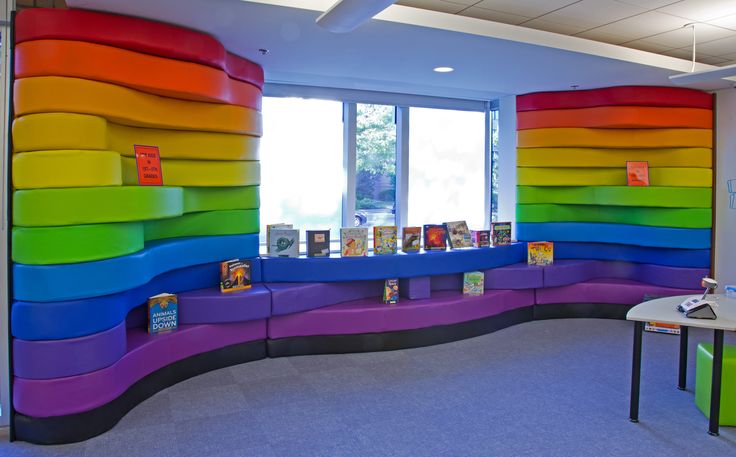
From 2014 through 2019, the library expanded and elevated its spaces, technologies, collections, and partnerships. Nearly 420,000 visitors were welcomed to the Main Library as it celebrated 10 years in the renovated building while South Branch celebrated 5 years at the Community Connections Center. A new public catalog, Enterprise, was rolled out and a 3M automated book return was installed to sort and check in returned materials. The library expanded its social media presence with Twitter and the circulation of electronic books increased significantly. A Discovery Zone in the Youth Services Department, offering interactive activities promoting STEM (Science, Technology, Engineering, and Math) skills for younger patrons, was completed in 2015. The Friends of the Library and Library Foundation continued supporting library programs and projects, including the Discovery Zone. For the first time, Library Journal designated the Mount Prospect Public Library as a Star Library. A Pinterest account was also added to the library’s array of social media platforms.
Many cooperative arrangements were made with Village organizations. The Mount Prospect Entrepreneurs Initiative (MPEI) was developed. This is a formal partnership involving the Library, the Village of Mount Prospect, the Mount Prospect Chamber of Commerce, and the Mount Prospect Downtown Merchants Association. Collaborative activities were also conducted with area schools and individual area businesses. Staff from South Branch and the Main Library offered a series of new programs presented in Polish for all ages. The Library Foundation hosted the first Mini Golf fundraiser with the temporary installation of an 18-hole course set up throughout the Main Library.
The second floor redesign and renovation project in 2016 created more inviting spaces for patrons with several meeting and study room spaces added, as well as a large, enclosed space dedicated for teen users. Upgraded signage and an improved wayfinding system was implemented to help patrons easily find their way through the space. The newly constructed Teen Space opened to the public on January 6. In July, artist Tally Fisher was on hand for her public art piece installation at the Main Library entitled Soft Rains. This is a stunning sculpture that was funded in part by the Friends of the Library. In response to a request by the Mount Prospect Centennial Commission, the library agreed to house and display items from the 1992 time capsule.
A new Bulgarian Language collection was developed and dedicated in 2017, with the encouragement of residents, celebrating the growing diversity of Mount Prospect. Upgrades and new resources in our digital and technology equipment offering included the OverDrive app, Libby. The library also began offering audiobooks for both adults and children through RBdigital. 3D printing became more popular as the technology librarian offered training on software used to create 3D objects on printers funded by the Friends of the Library. The library also explored how best to offer virtual reality equipment to patrons. SimpleScan machines, which scan, and email or fax materials were added for patrons to use. The Library Foundation celebrated 20 years of supporting the library community.
The library celebrated its 75th anniversary celebration with an Open House on September 23, 2018. The lobby underwent a makeover to include a separate area for patron self-service with self-check systems, Express computers, and a copier/printer. The Youth Department also unveiled a new look with the creation of a specially designed entryway, intended to create a portal through which children would enter a place of discovery and imagination. Artist Greg Gove painted Illinois flora and fauna, some of which peek through the openings in the canopy. More artwork was added to the second floor with the installation of Butterflies by Priscilla Robinson. The library joined Instagram to further connect with patrons through social media.
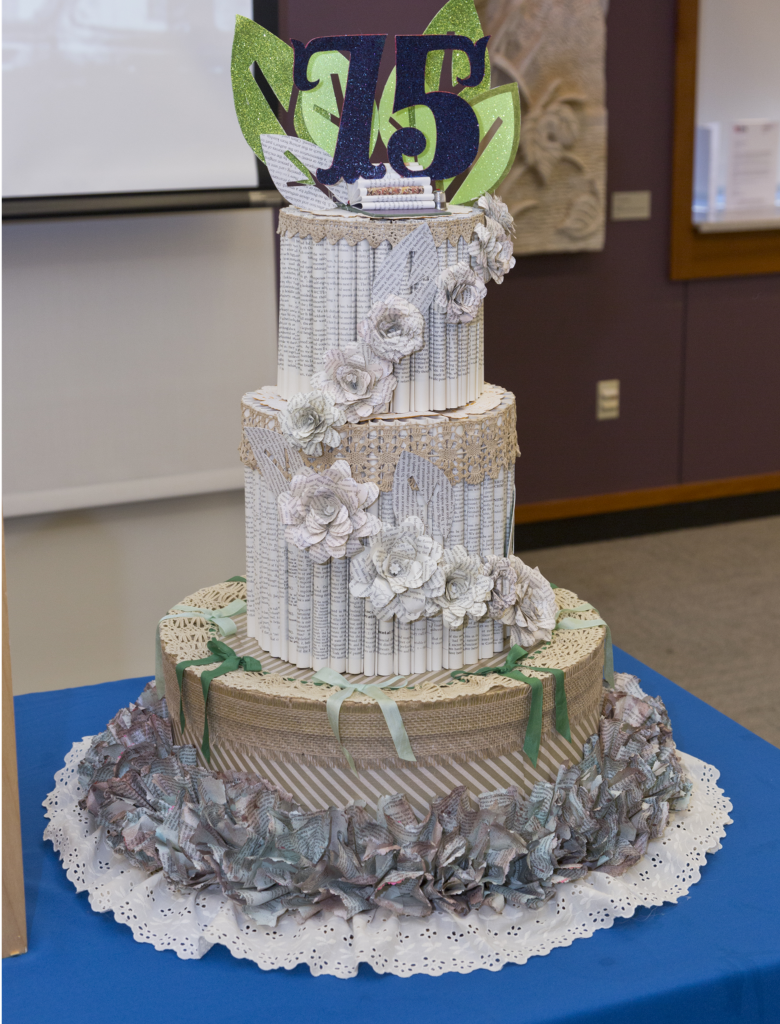
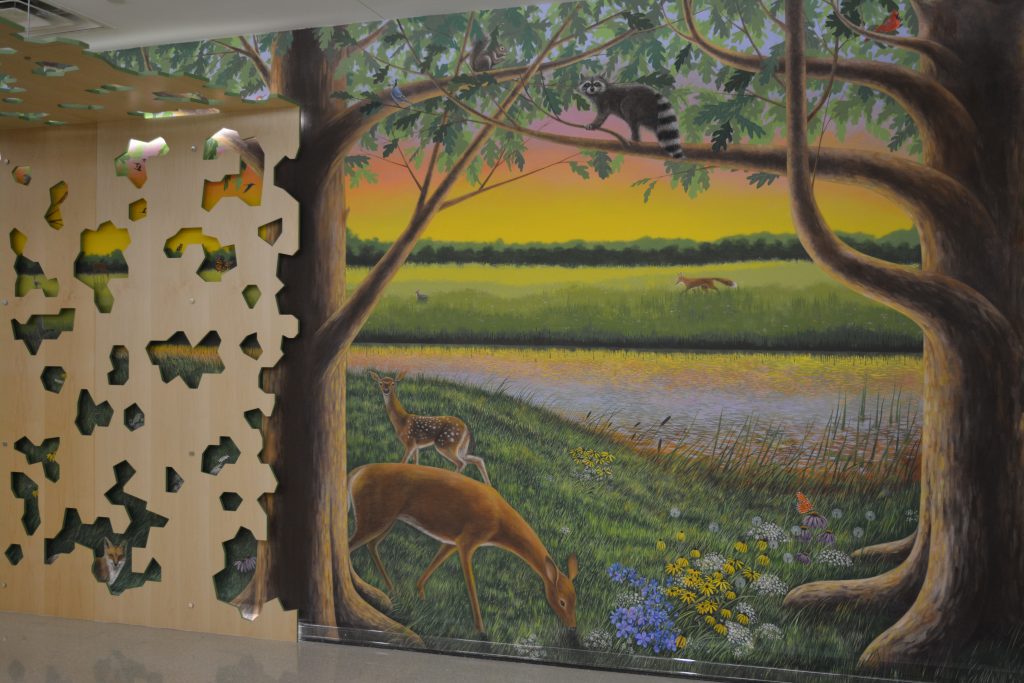
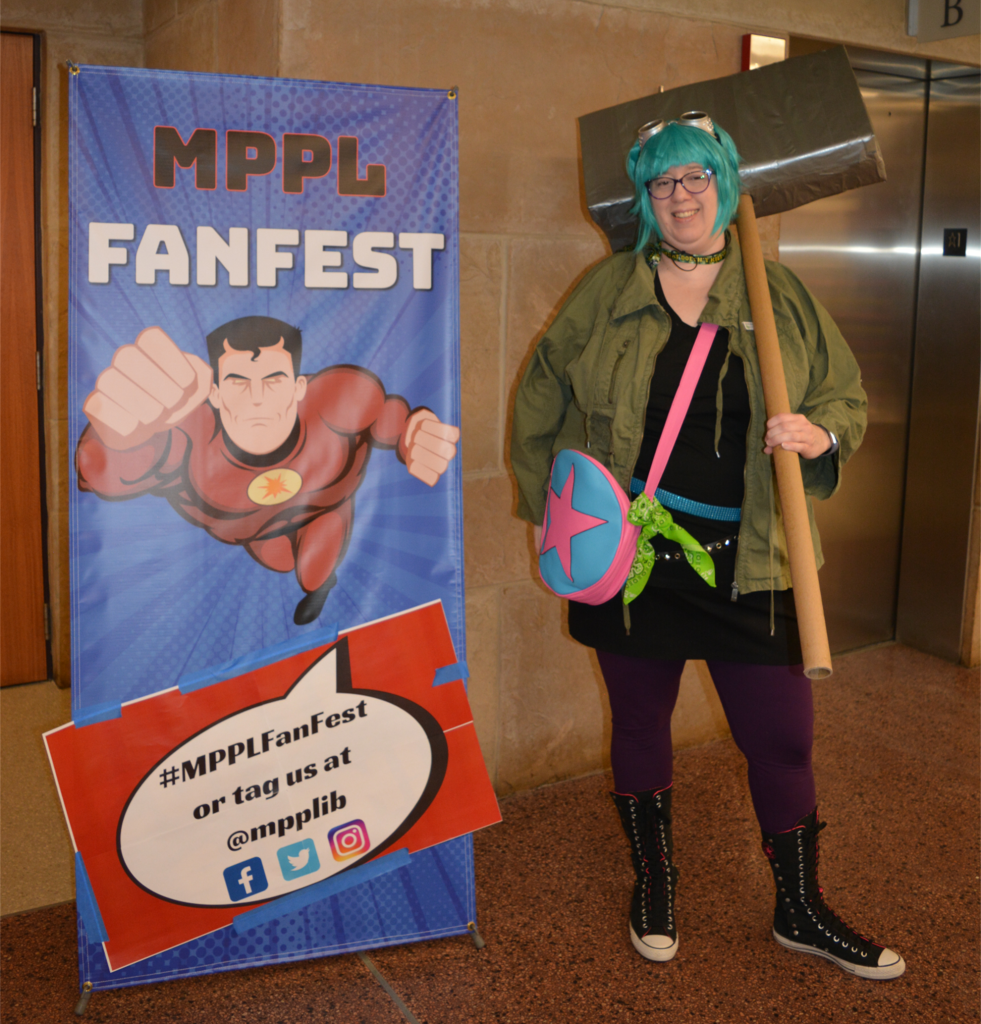
In June of 2019, the library community celebrated the work and retirement of longtime Executive Director Marilyn Genther. Su Reynders joined as the new Executive Director on July 1. The Kanopy streaming video service was added, and on October 1, the library launched automatic renewals. The first FanFest event, a Comic-Con style celebration of pop culture took place in February. Sponsored by Friends of the Library, more than 500 participants enjoyed a full day of festivities. On August 17, approximately 500 residents and invited guests celebrated the 10th anniversary of South Branch and the Community Connections Center.
The library had its services turned upside down by the global COVID-19 pandemic in March of 2020. Following guidelines set by the CDC and Illinois Department of Public Health, the library buildings were closed on March 15. The staff quickly began figuring out how to provide library services to the community during lockdown, including upgrading online library card registration for immediate use. Additional efforts were directed toward increasing digital media content offered to patrons. Phone, chat, text, and email support were provided to patrons. Staff storytime and singalong videos were uploaded to YouTube, and in April, virtual programming via Zoom began. Parking Lot Pickup, one of the most successful and defining services, was created for the Main Library and South Branch. This contactless delivery service placed library materials into the hands of patrons and was immediately received with positive feedback.
(Pictured right: Parking Lot Pickup, 2020)

While 2021 began on uncertain ground with the world navigating the coronavirus pandemic for a second year, it ended on a solid path forward to its “new normal.” Although the library was still closed to the public, contactless pickup, computers by appointment, and virtual programs continued. The Main Library reopened on February 1 and the South Branch opened on March 8 with limited capacity and time limits. As of April 1, the library became fine free. By August, library operations were mostly back to normal, with the exception that programs continued to be offered virtually.
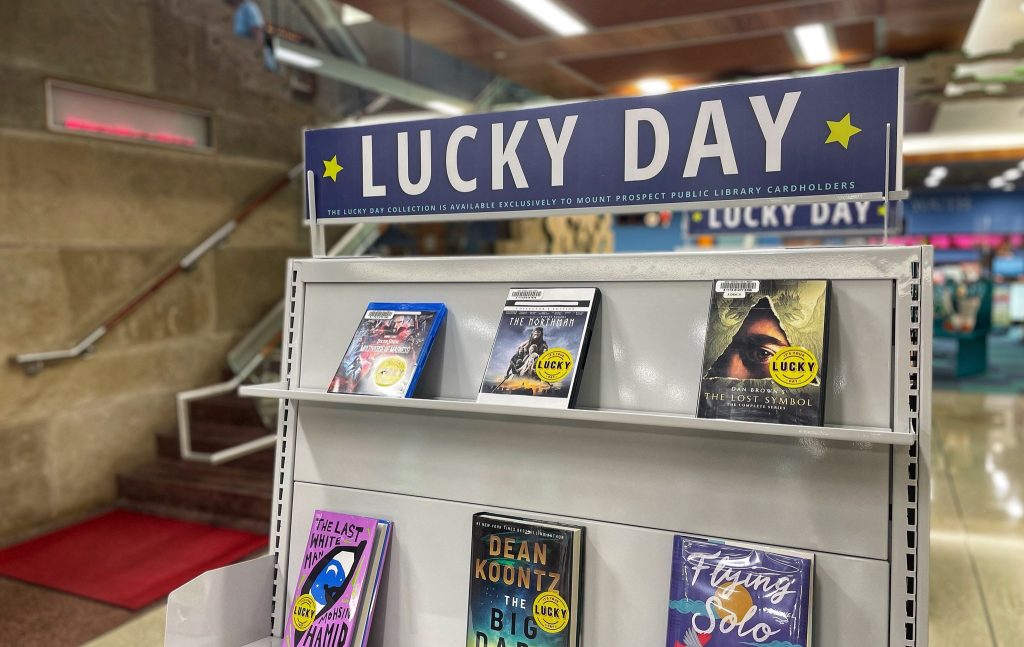
Early in 2022 Mount Prospect residents were asked to take part in a community survey to help explore ideas and services. Feedback received was used to develop a strategic plan which would guide the library over the next three years. In January, the library added hold lockers for convenient 24/7 material pickup; placed outside the lower-level entrance to the Main Library, they became very popular with patrons. In March, the library implemented automatic library card renewals so Mount Prospect patrons will not have to renew their cards in person. PC and Mac laptops were made available for use inside the library. The library collection was enhanced by the addition of more items to the Library of Things collection and the debut of the “Lucky Day” collection in July. Lucky Day items, available exclusively to Mount Prospect cardholders, include copies of the most popular, hard to get books and movies. With funds from a grant from the Illinois State Library, the library purchased two Mac Studio computers for public use. These studios include hardware and software that enable the conversion of photographs, negatives, slides, and VHS tapes to digital files.
